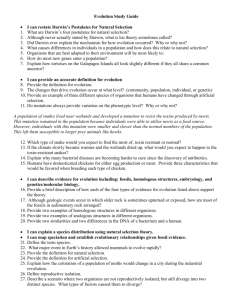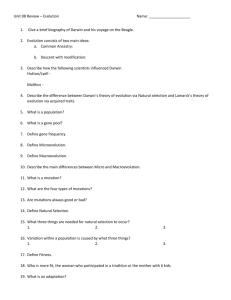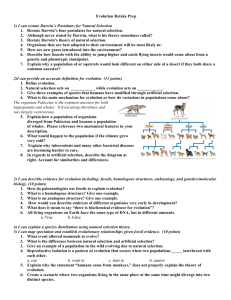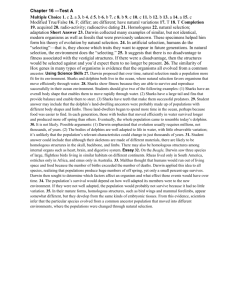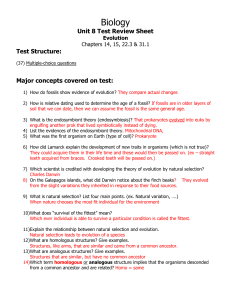EVOLUTION
advertisement
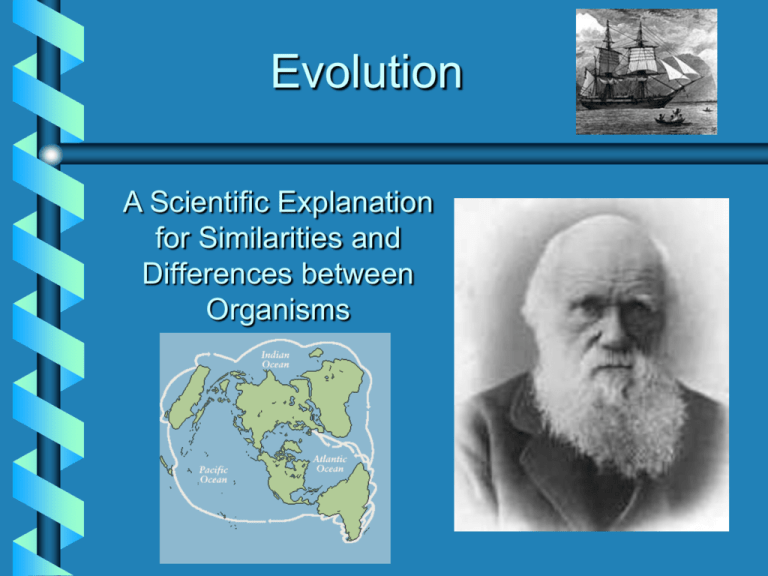
Evolution A Scientific Explanation for Similarities and Differences between Organisms Darwin’s Observations • Living Organisms resemble extinct fossil forms. Darwin’s Observations • Progressive changes from simpler to more complex organisms can be seen in the fossil record. Darwin’s Observations • Different island species resemble each other. Darwin’s Observations • Island Populations resemble those on nearby land. The Galapagos finches resembled the grassquit found on the coast of Ecuador. Darwin’s Observations • Lands with similar climates have unrelated plants and animals. Darwin’s Observations • Plants and animals of each continent are distinctive. A Flowchart of Evolutionary Reasoning Potential for rapid reproduction Relatively constant resources and population over time Competition for survival and reproduction (1) Variability in structures and behaviors NATURAL SELECTION On average, the fittest organisms leave the most offspring (2) Some variability is inherited (observations) (conclusions) EVOLUTION: The genetic makeup of the population changes over time, driven by natural selection (3) Darwin’s Theory of Evolution • Evolution occurs by natural selection. • Evolution = progressive change in the characteristics of organisms as a result of changes in genetic composition Darwin’s Theory of Evolution • Natural selection = mechanism for evolution • Process by which those individuals whose traits adapt them to their environment leave a larger number of offspring • An increase in frequency of genotypes that confer a favorable advantage in a given environment. Adaptations • Traits that make a species survival more likely • Can be – structural: physical features – functional: physiological, biochemical, metabolic features – behavioral mechanisms Natural Selection favors individuals that are well-adapted to the current environment.The adaptations are not “perfect” solutions. Applying Your Knowledge 1. Adaptation 2. Evolution 3. Natural selection A. The mechanism for evolution is B. A progressive change in the characteristics of organisms is C. A trait that makes a species survival more likely is called a(n) Evidence for Evolution: Fossil Record Evidence for Evolution: Geological • Sufficient time for evolution based on age of the earth Evidence for Evolution: Comparative Anatomy • Structures that do not show a common origin – Analogous structures: superficially similar • Structures that show a common origin – Homologous Structures: same evolutionary origin despite differences in function – Vestigial Structures: serve no purpose but are homologous to structures in related organisms Analogous Structures Not homologous; analogous Not homologous; not analogous Homologous; analogous Homologous; not analogous Homologous Structures Flying Swimming Running Grasping Vestigial Structures Remnants of hindlimb seen in boa and whale Functional hindlimb in salamander Evidence for Evolution: Embryology • Similar embryonic patterns of development Evidence for Evolution: Genetics • Mutation generates diversity • Meiosis and Fertilization generate new combinations due to – Crossing Over – Alternate patterns of chromosome segregation – Unique genotype of fertilizing sperm combined with unique genotype of egg Evidence for Evolution: Biochemistry • Molecular similarities between different organisms Evidence for Evolution: Molecular Biology • Similarities in sequence measured by ease of separating DNA strands by heat Evidence for Natural Selection • Artificial Selection Evidence for Natural Selection • Current Observations – Development of insecticide resistance in western corn rootworm larvae Chlorpyrifos Terbufos Methyl Parathion Tefluthrin Carbofuran Western corn rootworm larval bioassay results R LD50/S LD50. 0 5 10 15 Resistance Ratios 20 Natural Selection Data, p. 115 Color 1 P S O Color 2 P S O Color 3 P S O Color 4 P S O Color 5 P S O 20 __ 5 15 __ 20 __ 0 __ 0 20 __ 1 __ 3 20 __ 9 __ 27 2nd 40 __ 12 __ 36 __ 20 __ __ 6 18 __ __ 0 __ 0 __ 0 __ 4 __ 0 __ 0 __ __ 36 7 21 __ 0 __ 28 __ 1st 20 10 __ 30 __ 3rd 48 __ 24 __ 0 __ 4th 5th S= Survivors Must Total 25 O= Offspring = 3 x Survivors (Place on cloth) P= Pre-hunt = Survivors + Offspring Natural Selection Data, p. 115 Pre-Hunt Population 70 60 50 40 Color 1 30 Color 3 20 10 0 1 2 3 4 5 Breeding Season Plot Pre-Hunt population values for most and least successful colors Types of Natural Selection Large Size Average Size Extreme Size Favored Favored Favored Time Before Selection Mean changed over time After Selection Variation reduced over time Directional Stabilizing Selection Selection Variation becomes polarized Disruptive Selection Types of Selection • Stabilizing: eliminates extremes Stabilizing Selection & Balanced Polymorphism SS Homozygous Normal SS’ Heterozygous S’S’ Homozygous Defective Dies of malaria Lives and reproduces Dies of sickle-cell anemia SS SS’ S’S’ Dies of malaria Lives and reproduces Dies of sickle-cell anemia SS SS’ S’S’ Types of Selection • Disruptive: increases both extremes Types of Selection • Directional: increases one extreme Applying Your Knowledge 1. Stabilizing Selection 2. Disruptive Selection 3. Directional Selection Which type of selection has occurred if • The background is sandy with dark rocks and snails are found with either dark or light shell colors? • After spraying with malathion, more fruit flies are found to be resistant to this insecticide? Patterns of Evolution • Divergent – different phenotypes arise as related species encounter environmental differences Patterns of Evolution • Convergent – similar phenotypes arise in unrelated species as a result of environmental similarities North American Desert Plants Cactus African Desert Plants Euphorbs Patterns of Evolution • Convergent – similar phenotypes arise in unrelated species as a result of environmental similarities Meadowlark of North America Yellow-Throated Longclaw of Africa Patterns of Evolution • Coevolution: species adjust together to maintain relationship Predators and their Prey Flowering plants and their Pollinators

